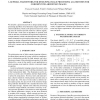Free Online Productivity Tools
i2Speak
i2Symbol
i2OCR
iTex2Img
iWeb2Print
iWeb2Shot
i2Type
iPdf2Split
iPdf2Merge
i2Bopomofo
i2Arabic
i2Style
i2Image
i2PDF
iLatex2Rtf
Sci2ools
113
click to vote
ICIP
2003
IEEE
2003
IEEE
A general framework for designing image processing algorithms for coherent polarimetric images
We describe a general framework to design optimal image processing algorithms for polarimetric images formed with coherent radiations, which can be optical or microwave. Starting from the classical speckle model for coherent signals, we show that a wide class of algorithms to perform such tasks as detection, localization and segmentation depend on a simple statistics, which is the determinant of the coherency matrix estimated on a given region of the image. We use this property to design computationally efficient techniques for target/edge detection and image segmentation using statistical active contours and the Minimum Description Length principle.
Classical Speckle Model | Coherent Radiations | ICIP 2003 | Image Processing | Image Processing Algorithms |
Related Content
| Added | 04 Jul 2010 |
| Updated | 04 Jul 2010 |
| Type | Conference |
| Year | 2003 |
| Where | ICIP |
| Authors | François Goudail, Frédéric Galland, Philippe Réfrégier |
Comments (0)

